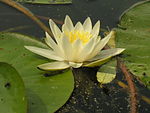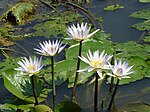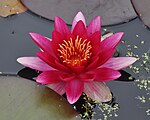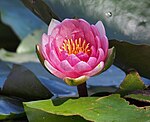Nymphaea
| Nymphaea | |
|---|---|

| |
| Nymphaea alba L., the type species of the genus[2] | |
| Scientific classification | |
| Kingdom: | Plantae |
| Clade: | Tracheophytes |
| Clade: | Angiosperms |
| Order: | Nymphaeales |
| Family: | Nymphaeaceae |
| Genus: | Nymphaea L. |
| Type species | |
| Nymphaea alba L.[2] | |
| Species | |
|
65 species, see text[1] | |
| Synonyms[1] | |
| |
Nymphaea (/nɪmˈfiːə/) is a genus of hardy and tender aquatic plants in the family Nymphaeaceae. The genus has a cosmopolitan distribution. Many species are cultivated as ornamental plants, and many cultivars have been bred. Some taxa occur as introduced species where they are not native,[3] and some are weeds.[4] Plants of the genus are known commonly as water lilies,[3][5] or waterlilies in the United Kingdom. The genus name is from the Greek νυμφαία, nymphaia and the Latin nymphaea, which means "water lily" and were inspired by the nymphs of Greek and Latin mythology.[3]
Description
[edit]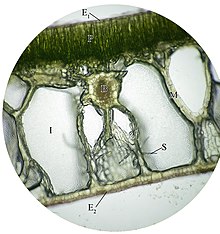
- E1: upper epiderm
- E2: lower epiderm
- P: palisade mesophyll
- M: spongy mesophyll
- B: vascular bundle
- I: intercellular gap
- S: sclerenchyma


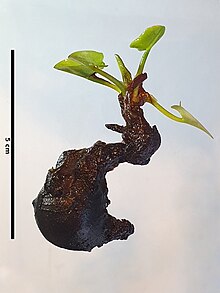



S = sepals, P = petals, St = stamina, An = anthers, O = ovary, SD = stigma disc, CT = carpellary teeth

Water lilies are aquatic rhizomatous herbaceous perennials, sometimes with stolons as well. The stem is angular and erect. The leaves grow from the rhizome on long petioles (stalk that attaches the leaf blade to the stem). Floating round leaves of waterlily grow up to 30 centimetres (12 inches) across. The disc-shaped leaf blades are notched and split to the stem in a V-shape at the centre, and are often purple underneath. Most of them float on the surface of the water. The leaves have smooth or spine-toothed edges, and they can be rounded or pointed.
The flowers rise out of the water or float on the surface, opening during the day or at night.[3] Some flower of species has different time to open as morning or evening to attract the insect; example, the flower of Nymphaea odorata open in the morning but close at noon. [6]Many species of Nymphaea display protogynous flowering. The temporal separation of these female and male phases is physically reinforced by flower opening and closing, so the first flower opening displays female pistil and then closes at the end of the female phase, and reopens with male stamens.[7] Each has at least eight petals in shades of white, pink, blue, or yellow. Many stamens are at the center.[3] Water lily flowers are entomophilous, meaning they are pollinated by insects, often beetles.[3] The fruit is berry-like and borne on a curving or coiling peduncle.[3] The plant reproduces by root tubers and seeds.
Taxonomy
[edit]The genus Nymphaea L. was described by Carl Linnaeus in 1753. It has three synonyms: Castalia Salisb. published by Richard Anthony Salisbury in 1805, Leuconymphaea Kuntze published by Otto Kuntze in 1891, and Ondinea Hartog published by Cornelis den Hartog in 1970.[1] The type species is Nymphaea alba L.[2]
Subgenera
[edit]The genus Nymphaea has been divided into several subgenera:
- Nymphaea subg. Anecphya (Casp.) Conard[8]
- Nymphaea subg. Brachyceras (Casp.) Conard[9]
- Nymphaea subg. Confluentes S.W.L.Jacobs[10]
- Nymphaea subg. Hydrocallis (Planch.) Conard[11]
- Nymphaea subg. Lotos (DC.) Conard[12]
- Nymphaea subg. Nymphaea (autonym)
Sections
[edit]The subgenus Nymphaea subg. Nymphaea has been divided into sections:
Species
[edit]As of January 2024, there are 65 accepted species by Plants of the World Online:[1]
- Nymphaea abhayana A.Chowdhury & M.Chowdhury
- Nymphaea alba L.
- Nymphaea alexii S.W.L.Jacobs & Hellq.
- Nymphaea amazonum Mart. & Zucc.
- Nymphaea ampla (Salisb.) DC.
- Nymphaea atrans S.W.L.Jacobs
- Nymphaea belophylla Trickett
- Nymphaea × borealis E.G.Camus
- Nymphaea caatingae C.T.Lima & Giul.
- Nymphaea candida C.Presl
- Nymphaea carpentariae S.W.L.Jacobs & Hellq.
- Nymphaea conardii Wiersema
- Nymphaea × daubenyana W.T.Baxter ex Daubeny
- Nymphaea dimorpha I.M.Turner
- Nymphaea divaricata Hutch.
- Nymphaea elegans Hook.
- Nymphaea elleniae S.W.L.Jacobs
- Nymphaea francae C.T.Lima & Giul.
- Nymphaea gardneriana Planch.
- Nymphaea georginae S.W.L.Jacobs & Hellq.
- Nymphaea gigantea Hook.
- Nymphaea glandulifera Rodschied
- Nymphaea gracilis Zucc.
- Nymphaea guineensis Schumach. & Thonn.
- Nymphaea harleyi C.T.Lima & Giul.
- Nymphaea hastifolia Domin
- Nymphaea heudelotii Planch.
- Nymphaea immutabilis S.W.L.Jacobs
- Nymphaea jacobsii Hellq.
- Nymphaea jamesoniana Planch.
- Nymphaea kakaduensis Hellq., A.Leu & M.L.Moody
- Nymphaea kimberleyensis (S.W.L.Jacobs) S.W.L.Jacobs & Hellq.
- Nymphaea lasiophylla Mart. & Zucc.
- Nymphaea leibergii (Morong) Rydb.
- Nymphaea lingulata Wiersema
- Nymphaea loriana Wiersema, Hellq. & Borsch
- Nymphaea lotus L.
- Nymphaea lukei S.W.L.Jacobs & Hellq.
- Nymphaea macrosperma Merr. & L.M.Perry
- Nymphaea maculata Schumach. & Thonn.
- Nymphaea manipurensis Asharani & Biseshwori
- Nymphaea mexicana Zucc.
- Nymphaea micrantha Guill. & Perr.
- Nymphaea noelae S.W.L.Jacobs & Hellq.
- Nymphaea nouchali Burm.f.
- Nymphaea novogranatensis Wiersema
- Nymphaea odorata Aiton
- Nymphaea ondinea Löhne, Wiersema & Borsch
- Nymphaea oxypetala Planch.
- Nymphaea paganuccii C.T.Lima & Giul.
- Nymphaea pedersenii (Wiersema) C.T.Lima & Giul.
- Nymphaea potamophila Wiersema
- Nymphaea prolifera Wiersema
- Nymphaea pubescens Willd.
- Nymphaea pulchella DC.
- Nymphaea rapinii C.T.Lima & Giul.
- Nymphaea rubra Roxb. ex Andrews
- Nymphaea rudgeana G.Mey.
- Nymphaea siamensis Puripany.
- Nymphaea stuhlmannii (Engl.) Schweinf. & Gilg
- Nymphaea sulphurea Gilg
- Nymphaea × sundvikii Hiitonen
- Nymphaea tenuinervia Casp.
- Nymphaea tetragona Georgi
- Nymphaea thermarum Eb.Fisch.
- Nymphaea × thiona D.B.Ward
- Nymphaea vanildae C.T.Lima & Giul.
- Nymphaea vaporalis S.W.L.Jacobs & Hellq.
- Nymphaea violacea Lehm.
Fossil species
[edit]- †Nymphaea brongniartii (Caspary) Saporta[15]
Evolutionary relationships
[edit]The genus Nymphaea may be paraphyletic in its current circumscription, as the genera Euryale and Victoria have been placed within the genus Nymphaea in several studies.[16][17][18]
Conservation
[edit]Several species are in danger of extinction. Nymphaea thermarum is classified as critically endangered (CR),[19] Nymphaea loriana is classified as endangered (EN),[20] Nymphaea stuhlmannii is classified as endangered (EN),[21] and Nymphaea nouchali var. mutandaensis is also classified as endangered (EN).[22]
Cultivation
[edit]Water lilies are not only decorative, but also provide useful shade which helps reduce the growth of algae in ponds and lakes.[23] Many of the water lilies familiar in water gardening are hybrids and cultivars. These cultivars have gained the Royal Horticultural Society's Award of Garden Merit:

- 'Escarboucle'[24] (orange-red)
- 'Gladstoniana'[25] (double white flowers with prominent yellow stamens)
- 'Gonnère'[26] (double white scented flowers)
- 'James Brydon;'[27] (cupped rose-red flowers)
- 'Marliacea Chromatella'[28] (pale yellow flowers)
- 'Pygmaea Helvola'[29] (miniature, with cupped fragrant yellow flowers)
Uses
[edit]This section needs additional citations for verification. (June 2022) |
All water lilies are poisonous and contain an alkaloid called nupharin in almost all of their parts,[30] with the exception of the seeds and in some species, the tubers.
The European species contain large amounts of nupharin, and are considered inedible. The amount of nupharin in the leaves and stalks appears to vary seasonally in European species.
In some species, the rhizomes and tubers are eaten after boiling has neutralised the nupharin.
The tubers of a number of Australian, Asian and African species are completely edible, during the dry season some consist almost entirely of starch.
The Ancient Egyptians ate them boiled.
In India, it has mostly been eaten as a famine food or as a medicinal (both cooked),[31] but in one area the dried rhizomes were pounded into a sort of bread, and the tubers are often eaten in the floodplains.
In Vietnam, the rhizomes were eaten roasted.
In Sri Lanka it was formerly eaten as a type of medicine and its price was too high to serve as a normal meal, but in the 1940s or earlier some villagers began to grow water lilies in the paddy fields left uncultivated during the monsoon season (Yala season), and the price dropped. The tubers are called manel here and eaten boiled and in curries.[31]
The tubers of all occurring species were eaten in West Africa and Madagascar (where they are called tantamon for blue and laze-laze for white), usually boiled or roasted.
In West Africa, usage varied between cultures, in the Upper Guinea the rhizomes were only considered famine foods - here the tubers were either roasted in ashes, or dried and ground into a flour. The Buduma people ate the seeds and rhizomes. Some tribes ate the rhizomes raw. The Hausa people of Ghana, Nigeria and the people of Southern Sudan used the tubers of Nymphaea lotus, the seeds (inside the tubers) are locally referred to as 'gunsi' in Ghana. They are ground into flour.[32]
In China the tubers were eaten cooked.
The plants were also said to be eaten in the Philippines. In the 1950s there were no records of leaves or flowers being eaten.[33]
In a North American species, the boiled young leaves and unopened flower buds are said to be edible. The seeds, high in starch, protein, and oil, may be popped, parched, or ground into flour. Potato-like tubers can be collected from the species N. tuberosa (=N. odorata).[34]
The tubers of Nymphaea gigantea of Australia were roasted by certain tribes, these turn the colour blue when boiled, the tubers of other species were also roasted elsewhere on that continent.
Water lilies were said to have been a major food source for a certain tribe of indigenous Australians in 1930, with the flowers and stems eaten raw, while the "roots and seedpods" were cooked either on an open fire or in a ground oven.[35]

Culture
[edit]


The Ancient Egyptians used the water lilies of the Nile as cultural symbols.[36] Since 1580 it has become popular in the English language to apply the Latin word lotus, originally used to designate a tree, to the water lilies growing in Egypt, and much later the word was used to translate words in Indian texts.[37] The lotus motif is a frequent feature of temple column architecture. In Egypt, the lotus, rising from the bottom mud to unfold its petals to the sun, suggested the glory of the sun's own emergence from the primaeval slime. It was a metaphor of creation. It was a symbol of the fertility gods and goddesses as well as a symbol of the upper Nile as the giver of life.[36]
A Roman belief existed that drinking a liquid of crushed Nymphaea in vinegar for 10 consecutive days turned a boy into a eunuch.[38]
A Syrian terra-cotta plaque from the 14th–13th centuries BC shows the goddess Asherah holding two lotus blossoms. An ivory panel from the 9th-8th centuries BC shows the god Horus seated on a lotus blossom, flanked by two cherubs.[39]
The French Impressionist painter Claude Monet is known for his many paintings of water lilies in the pond in his garden at Giverny.[40]
N. nouchali is the national flower of Bangladesh[41] and Sri Lanka.[42]
Water lilies are also used as ritual narcotics. According to one source, this topic "was the subject of a lecture by William Emboden given at Nash Hall of the Harvard Botanical Museum on the morning of April 6, 1979".[43]
Examples
[edit]-
Nymphaea 'Attraction'
-
Nymphaea "Laydekeri Purpurata"
-
Nymphaea sp.
See also
[edit]- Albert de Lestang, propagator and seed collector
- List of plants known as lily
References
[edit]- ^ a b c d "Nymphaea L." Plants of the World Online. Royal Botanic Gardens, Kew. Retrieved 9 January 2024.
- ^ a b c Nymphaea | International Plant Names Index. (n.d.). Retrieved June 26, 2023, from https://www.ipni.org/n/330032-2
- ^ a b c d e f g Nymphaea. Flora of North America.
- ^ Nymphaea. The Jepson eFlora 2013.
- ^ Nymphaea. Integrated Taxonomic Information System (ITIS).
- ^ Schneider, Edward L.; Chaney, Tim (1981). "The Floral Biology of Nymphaea odorata (Nymphaeaceae)". The Southwestern Naturalist. 26 (2): 159–165. doi:10.2307/3671112. ISSN 0038-4909.
- ^ Povilus, R. A.; Losada, J. M.; Friedman, W. E. (2015). "Floral biology and ovule and seed ontogeny of Nymphaea thermarum, a water lily at the brink of extinction with potential as a model system for basal angiosperms". Annals of Botany. 115 (2): 211–226. doi:10.1093/aob/mcu235. PMC 4551091. PMID 25497514.
- ^ "Nymphaea subgen. Anecphya | International Plant Names Index". www.ipni.org. Retrieved 2024-11-07.
- ^ "Nymphaea subgen. Brachyceras | International Plant Names Index". www.ipni.org. Retrieved 2024-11-07.
- ^ "Nymphaea subgen. Confluentes | International Plant Names Index". www.ipni.org. Retrieved 2024-11-07.
- ^ "Nymphaea subgen. Hydrocallis | International Plant Names Index". www.ipni.org. Retrieved 2024-11-07.
- ^ "Nymphaea subgen. Lotos | International Plant Names Index". www.ipni.org. Retrieved 2024-11-07.
- ^ "Nymphaea sect. Chamaenymphaea | International Plant Names Index". www.ipni.org. Retrieved 2024-11-07.
- ^ "Nymphaea sect. Xanthantha | International Plant Names Index". www.ipni.org. Retrieved 2024-11-07.
- ^ Butzmann, R., & Fischer, T. C. (2013). "Fossil water lily fruits with seeds Nymphaea subgenus Lotos, from the Oligocene of Armissan/Narbonne (France)." Zitteliana, 93-104.
- ^ He, D., Gichira, A. W., Li, Z., Nzei, J. M., Guo, Y., Wang, Q., & Chen, J. (2018). Intergeneric relationships within the early-diverging angiosperm family Nymphaeaceae based on chloroplast phylogenomics. International Journal of Molecular Sciences, 19(12), 3780.
- ^ Loehne, C., Borsch, T., & Wiersema, J. H. (2007). Phylogenetic analysis of Nymphaeales using fast-evolving and noncoding chloroplast markers. Botanical Journal of the Linnean Society, 154(2), 141-163.
- ^ Roestel, J. A., Wiersema, J. H., Jansen, R. K., Borsch, T., & Gruenstaeudl, M. (2024). On the importance of sequence alignment inspections in plastid phylogenomics–an example from revisiting the relationships of the water‐lilies. Cladistics.
- ^ Abeli, T. 2024. Nymphaea thermarum. The IUCN Red List of Threatened Species 2024: e.T185459A249717119. Accessed on 29 October 2024.
- ^ Lansdown, R.V. 2017. Nymphaea loriana. The IUCN Red List of Threatened Species 2017: e.T81359075A81360324. https://dx.doi.org/10.2305/IUCN.UK.2017-3.RLTS.T81359075A81360324.en. Accessed on 29 October 2024.
- ^ Mollel, N. 2024. Nymphaea stuhlmannii. The IUCN Red List of Threatened Species 2024: e.T185721A248552468. Accessed on 29 October 2024.
- ^ Luke, W.R.Q., Gereau, R., Beentje, H.J., Kabuye, C., Nshutiyayesu, S. & Ntore, S. 2019. Nymphaea nouchali var. mutandaensis. The IUCN Red List of Threatened Species 2019: e.T111322366A111322382. https://dx.doi.org/10.2305/IUCN.UK.2019-2.RLTS.T111322366A111322382.en. Accessed on 29 October 2024.
- ^ RHS A-Z Encyclopedia of Garden Plants. United Kingdom: Dorling Kindersley. 2008. p. 1136. ISBN 978-1405332965.
- ^ "RHS Plant Selector - Nymphaea 'Escarboucle'". Retrieved 16 January 2021.
- ^ "RHS Plant Selector - Nymphaea 'Gladstoniana'". Retrieved 16 January 2021.
- ^ "RHS Plant Selector - Nymphaea 'Gonnere'". Retrieved 16 January 2021.
- ^ "RHS Plant Selector - Nymphaea 'James Brydon'". Retrieved 16 January 2021.
- ^ "RHS Plant Selector - Nymphaea 'Marliacea Chromatella'". Retrieved 16 January 2021.
- ^ "RHS Plant Selector - Nymphaea 'Pygmaea Helvola'". Retrieved 16 January 2021.
- ^ Chapter 10 Nuphar Alkaloids. J.T. Wróbel, The Alkaloids: Chemistry and Physiology, 1967, Volume 9, Pages 441–465, doi:10.1016/S1876-0813(08)60206-7
- ^ a b Tiwari, Ashok (September 2019). "Nutritional composition and antioxidative stress properties in boiled tuberous rhizome of Neel Kamal (Nymphaea nouchali Burm. f.)". Indian Journal of Natural Products and Resources. 10 (1): 59–67.
- ^ Adanse, John; Bigson, Kate; Dare, Nyefene Joe; Glago, Patricia (2021). "Proximate and Functional Properties of Water Lily (Nymphaea Lotus),Coconut (Cocos Nicifera) and Wheat (Titricum Aestivum) Flour Blends". J Food Tech Food Chem. 3: 104.
- ^ FR Irvine, RS Trickett - Water lilies as Food - Kew Bulletin, 1953
- ^ Peterson, L. A. (1977). A Field Guide to the Wild Edible Plants of Eastern and Central North America. New York, New York: Houghton Mifflin. p. 22.
- ^ McConnel, U. H. 1930. ‘The Wik-Munkan Tribe of Cape York Peninsula’. Oceania 1: 97–108
- ^ a b Tresidder, Jack (1997). The Hutchinson Dictionary of Symbols. London: Duncan Baird Publishers. p. 126. ISBN 1-85986-059-1.
- ^ Harper, Douglas. "The Origin and Meaning of the word 'Lotus'". Etymology Online. Douglas Harper. Retrieved 1 April 2021.
- ^ Marcellus Empiricus, De medicamentis 33.64; compare Pliny the Elder, Natural History 25.75 (37). "There is an herb called nymphaea in Greek, 'Hercules’ club' in Latin, and baditis in Gaulish. Its root, pounded to a paste and drunk in vinegar for ten consecutive days, has the astonishing effect of turning a boy into a eunuch."
- ^ Dever, W. G. Did God have a Wife? Archeology and Folk Religion in Ancient Israel. Wm. B. Eerdmans Publishing Co. 2008. pp 221, 279.
- ^ "Water Lilies: Claude Monet (French, 1840–1926)". Heilbrunn Timeline of Art History. Metropolitan Museum of Art. December 2008. Retrieved 8 March 2015.
- ^ "Bangladesh Constitution. Part I, The Republic, 4(3)". Archived from the original on 2013-10-29. Retrieved 2013-06-22.
- ^ Jayasuriya, M. Our national flower may soon be a thing of the past. The Sunday Times April 17, 2011.
- ^ "The Ethnopharmacology Society Newsletter". Vol. 2, no. 4. Spring 1979.
External links
[edit]Further reading
[edit]- Slocum, P. D. Waterlilies and Lotuses. Timber Press. 2005. ISBN 0-88192-684-1 (restricted online version at Google Books)

